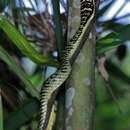tr
kırıntılardaki isimler


Die Ahaetullinae sind eine Unterfamilie der Nattern (Colubridae), die von Pakistan über Indien, Sri Lanka, Nepal und Bangladesch bis Südostasien, das südliche China, die Philippinen, Neuguinea und das nordöstliche Australien verbreitet ist. Die meisten Arten der Unterfamilie sind baumbewohnend und leben in Wäldern, einige auch in anderen Biotopen.
Diagnostisches Merkmal der Unterfamilie sind die gekielten, bei einigen Arten auch seitlich eingebuchteten Bauchschuppen (Ventralia) und die ebenfalls gekielten Schuppen auf der Schwanzunterseite (Subcaudalen), sowie im hinteren Kieferbereich befindliche gefurchte Fangzähne. Diese fehlen bei einigen Arten der Gattung Dendrelaphis. Innerhalb der Unterfamilie lassen sich zwei monophyletische Kladen unterscheiden. Arten der Gattungen Ahaetulla und Dryophiops besitzen lange, seitlich abgeflachte Körper mit 15 Reihen glatter Schuppen auf der mittleren Rückenregion, einem langen Kopf und großen Augen mit horizontal stehenden Pupillen und einem deutlich entwickelten Canthus rostralis. Chrysopelea und Dendrelaphis-Arten sind schlank mit einem annähernd rechteckigen Kopf und großen Augen mit runden Pupillen. Auf dem Rücken der Körpermitte befinden sich 13 bis 17 Reihen schwach gekielter Schuppen.[1] Proahaetulla ist die Schwestergattung von Ahaetulla und unterscheidet sich von den anderen Gattungen der Ahaetullinae durch 12 bis 13 Rückenschuppenreihen mit teilweise gesägten Graten, 20 Zähne im Oberkiefer (Maxillare) und 3 Postocularschuppen.[2] Die Gattung Chrysopelea ist wegen ihrer Fähigkeit berühmt, von Baum zu Baum gleiten zu können und die Arten der Gattung Dendrelaphis sind in der Lage von Ast zu Ast zu springen.[1]
Ahaetullinae ist die Schwestergruppe der Eigentlichen Nattern (Colubrinae), zu denen sie bis zu ihrer Erstbeschreibung im Jahr 2016 gezählt wurden.[1]
Zur Unterfamilie Ahaetullinae gehören fünf Gattungen mit 65 Arten.[3]
Die Ahaetullinae sind eine Unterfamilie der Nattern (Colubridae), die von Pakistan über Indien, Sri Lanka, Nepal und Bangladesch bis Südostasien, das südliche China, die Philippinen, Neuguinea und das nordöstliche Australien verbreitet ist. Die meisten Arten der Unterfamilie sind baumbewohnend und leben in Wäldern, einige auch in anderen Biotopen.
The Ahaetuliinae are a subfamily of the snake family Colubridae that was erected in 2016 and comprises five genera containing 63 species (Ahaetulla [17 species], Chrysopelea [5 species], Dendrelaphis [45 species], Dryophiops [2 species] and Proahaetulla [1 species]) that are more closely related to one another than to members of the subfamily Colubrinae. Previously placed within Colubrinae, Ahaetuliinae was strongly supported as the sister group to Colubrinae in a 2016 study by Figueroa et al.[1][2]
Ahaetuliine snakes are arboreal and have keeled ventral and subcaudal scales (laterally notched in some species), and enlarged posterior grooved fangs (lacking in some Dendrelaphis).[1] The name comes from the genus Ahaetulla, which gets its name from the Sri Lankan Sinhalese language words ahaetulla/ahata gulla/as gulla, meaning “eye plucker” or “eye picker”, because of the belief that they pluck out the eyes of humans, as first reported by the Portuguese traveler João Ribeiro in 1685.[3]
Ahaetuliinae are distributed from Pakistan, through India, Sri Lanka, Nepal, and Bangladesh, throughout Southeast Asia into southeastern China, in the Philippines, the Malay Archipelago, Papua New Guinea, and northeastern Australia.[1] Most species are found in forests. Notable traits include gliding in Chrysopelea, jumping behavior in Dendrelaphis, and horizontal keyhole-shaped pupils in Ahaetulla.
The Ahaetuliinae are a subfamily of the snake family Colubridae that was erected in 2016 and comprises five genera containing 63 species (Ahaetulla [17 species], Chrysopelea [5 species], Dendrelaphis [45 species], Dryophiops [2 species] and Proahaetulla [1 species]) that are more closely related to one another than to members of the subfamily Colubrinae. Previously placed within Colubrinae, Ahaetuliinae was strongly supported as the sister group to Colubrinae in a 2016 study by Figueroa et al.
Ahaetuliine snakes are arboreal and have keeled ventral and subcaudal scales (laterally notched in some species), and enlarged posterior grooved fangs (lacking in some Dendrelaphis). The name comes from the genus Ahaetulla, which gets its name from the Sri Lankan Sinhalese language words ahaetulla/ahata gulla/as gulla, meaning “eye plucker” or “eye picker”, because of the belief that they pluck out the eyes of humans, as first reported by the Portuguese traveler João Ribeiro in 1685.
Ahaetuliinae are distributed from Pakistan, through India, Sri Lanka, Nepal, and Bangladesh, throughout Southeast Asia into southeastern China, in the Philippines, the Malay Archipelago, Papua New Guinea, and northeastern Australia. Most species are found in forests. Notable traits include gliding in Chrysopelea, jumping behavior in Dendrelaphis, and horizontal keyhole-shaped pupils in Ahaetulla.
Ahaetuliinae – podrodzina węży z rodziny Colubridae (połozowate).
Do podrodziny zaliczanych jest 61 gatunków zgrupowanych w 4 rodzajach[1]:
Ahaetuliinae – podrodzina węży z rodziny Colubridae (połozowate).
Do podrodziny zaliczanych jest 61 gatunków zgrupowanych w 4 rodzajach:
Ahaetulla Chrysopelea Dendrelaphis DryophiopsAs Ahaetuliinae são uma subfamília da família da cobra Colubridae que foi erguida em 2016 para abrigar quatro gêneros contendo 56 espécies (Ahaetulla [8 espécies], Chrysopelea [5 espécies], Dendrelaphis [41 espécies] e Dryophiops [2 espécies]) que são mais intimamente relacionados entre si do que com os membros da subfamília Colubrinae.[1][2]
As Ahaetuliinae são uma subfamília da família da cobra Colubridae que foi erguida em 2016 para abrigar quatro gêneros contendo 56 espécies (Ahaetulla [8 espécies], Chrysopelea [5 espécies], Dendrelaphis [41 espécies] e Dryophiops [2 espécies]) que são mais intimamente relacionados entre si do que com os membros da subfamília Colubrinae.